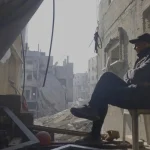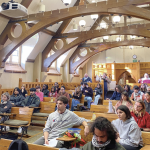Talia Cutler ’27
Executive Opinion Editor
On Wednesday, Sept. 4, Apalachee High School in Winder, Georgia was the site of a school shooting in which four people were killed and nine others injured. The Barrow County school system had been in session for 25 days. This was the 23rd K-12 school shooting in 2024.
My first memory of the phrase “school shooting” was in December of 2012. I was in second grade, the same age as many of the victims of the Sandy Hook shooting. I remember being confused. How could anyone do such a thing? Why did no one stop it? This was coupled with the slow realization that nothing was stopping anyone from doing the same at my school. 316 miles away from Newtown, Conn., I felt afraid. On the news for the first time, I heard words like “gun legislation,” “AR-15” and “Columbine.”
In seventh grade, the Parkland shooting took place on Valentine’s Day. I was passing out candy hearts to my classmates as Marjory Stoneman Douglas High School lost 17 students to a gunman. On social media, I saw “gun legislation,” “AR-15” and “Sandy Hook.”
In my junior year of high school, 21 people died in a mass shooting in Uvalde at an elementary school. I did not turn on the TV, nor did I open Instagram. Still, I heard the outcry — “gun legislation,” “AR-15” and “Parkland.”
At some point in my life, shootings became background noise much like all the other unspeakable traumas that plague the news cycle. With each shout of “never again,” (followed by a subsequent “again”) the words gradually began to lose their meaning. Is this ignorant? Maybe. But am I really responsible for change? Are any of us?
Including the Apalachee shooter, countless perpetrators of school shootings had been questioned by police or had reports filed against them before the attack. The Parkland shooter had 23 calls made about him to the Sheriff’s office, including tips that he had threatened to “shoot up the school,” and that he might be a “school shooter in the making.” During the Parkland shooting, school deputy Scot Peterson stood outside the building for 40 minutes as the shooter killed students and teachers. Similarly, at Robb Elementary in Uvalde in 2022, police officers stood outside for 77 minutes as the gunman was left alone with the children. There have been countless laws struck down that advocate for gun safety and regulations, with all the major legislation being entirely reactionary.
To further insult to injury, after a massacre comes denial. Conspiracy theorists like Alex Jones and James Tracy asserted that Sandy Hook was a “hoax,” that the victims were “child actors” and that “no one died.” An anonymous Florida student wrote a plea on Reddit under r/QanonCasualties headlined, “I’m a Parkland Shooting Survivor. QAnon Convinced My Dad It Was All a Hoax.” The student, whose identity was confirmed with Vice but kept private, said that his father was convinced he was a “paid pawn” in a “grand conspiracy.” And thus, essential conversations devolve into half-witted ravings. A struggle for action turns into a battle to get people to believe what is right in front of them.
As you can see, there is a formula to tragedy. It is as predictable as it is horrifying. Gun laws remain the same. AR-15s can still shoot 60 rounds a minute. Somewhere in America, there is a school that is next. Outcry turns into political sniping. Denial runs rampant.
You may find that the repetitive nature of these shootings suggests that there is something you can do about it. As pessimistic and brash as it may sound, the infographic on your Instagram story will not bring the victims back. It will not secure schools. It will not even change your congressman’s mind. Raising awareness, organizing marches, and lobbying have hit a wall. We have reached a point where shootings have shaped our education system. It is ingrained in curriculums, from active shooter drills to reinforced classroom doors. This fall, there was a back-to-school sale on bulletproof backpacks.
In July of this year, West Virginia passed the “Campus Self-Defense Act,” allowing people with concealed carry permits to have firearms on public college and university campuses. Governor Jim Justice described signing the bill as a “proud day for me.” 11 other states have passed similar laws.
This law does not protect students. Instead, it is one of the most dangerous and idiotic gun laws in the country (of which there are plenty). By framing it as an issue of “self-defense,” Justice repeats a fallacious idea that more guns will somehow decrease gun violence, as if those who are carrying are truly pacifists at heart. Whatever you choose to believe, the facts don’t lie: States with stronger gun laws have fewer gun-related deaths. What a sensational idea!
Will there be any strong gun laws in the near future? Probably not. Rural areas, where gun culture is more prevalent, have key votes and have shown an unwillingness to invest in safety. National gun control would be the only solution, and at this point in our political standing, I do not see that happening. Production of assault weapons has more than doubled in the last 15 years, and guns have become as essential to the American image as hot dogs and bald eagles.
The Apalachee shooting will not be the last school shooting in 2024. The cycle will repeat because that’s what cycles do. So argue about gun legislation and the ethics of AR-15s. Draw your comparisons to Columbine, Sandy Hook, Parkland, Uvalde, Virginia Tech, to Santa Fe or Nashville — but as Mason Schermerhorn, Christian Angulo, Christina Irimie and Richard Aspinwall are being buried, WVU is installing gun lockers in their residence halls. How can this be reformed? To put it simply, it can’t. If pattern recognition is too hard for you, let me be clear: The shooting last Wednesday will not be a tipping point in our country — it was an American Wednesday.


+ There are no comments
Add yours